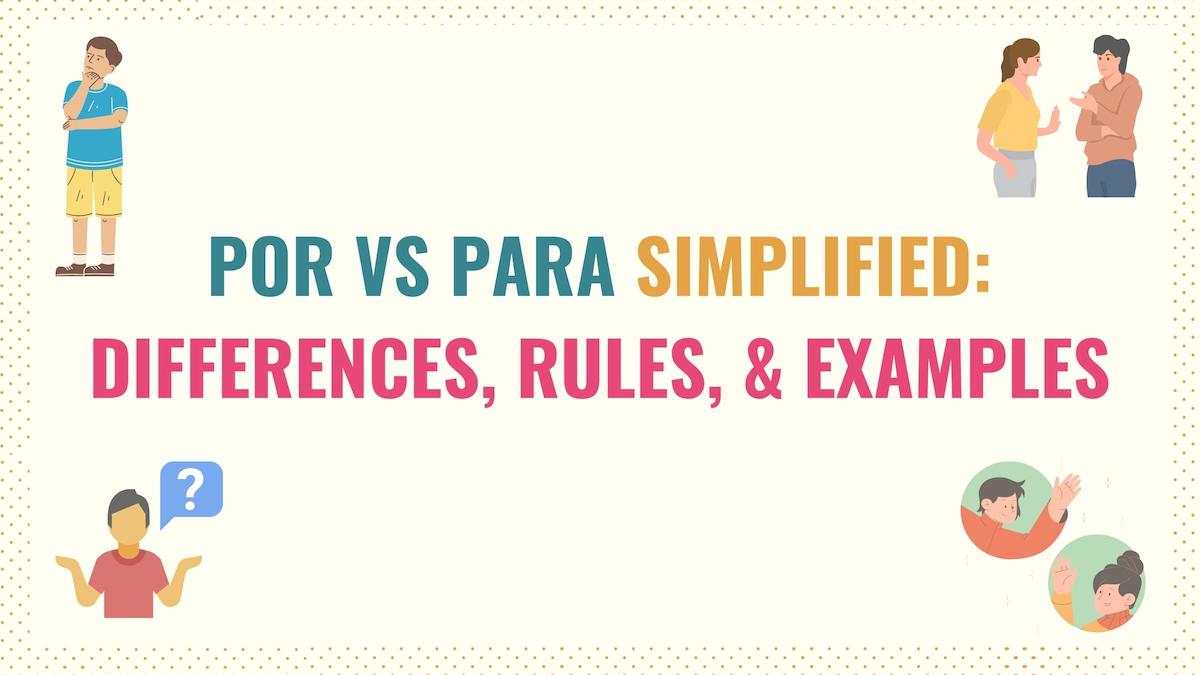Por vs para is a topic that holds a place of honor among all Spanish tricky words. Confusing these basic prepositions can hurt your fluency and, in some cases, affect the meaning of your sentence. Seeing how important these words are, in this guide, you’ll find key information you need to master por and para.
- Overview of Por vs Para
- Differences Between Por & Para
- Bonus Expressions with Por & Para
- Key Points
- What to Do Next
Before we begin, here is a little piece of advice. Don’t rely on direct translation since, often, por and para can be the equivalent of the same English preposition. Instead, focus on understanding their particular uses.
Overview of Por vs Para: Uses & Examples
Here are the uses of por and para:
Para:
- Purpose or goal
- Recipient
- Opinion
- Deadline
- Destination or direction
Por:
- Time durations and temporal references
- Reason or cause
- Express rough proximity and motion
- Communication
- Exchange money or other resources
Check these sentences using para:
Me mudé para ahorrar dinero.
I moved to save money.
Las galletas son para ti.
The cookies are for you.
Para mí, no vale la pena.
To me, it’s not worth it.
La entrega es para el lunes.
The delivery is for Monday.
Voy para el aeropuerto, ¿te llevo?
I’m going to the airport. Do you want a ride?
And here are some sentences using por:
Me mudé por mi trabajo.
I moved because of my job.
Ella toma café por las mañanas.
She drinks coffee in the morning.
Apenas voy por el aeropuerto.
I’m near the airport.
Te mandé las fotos por correo.
I sent you the pictures by email.
Pagué $2000 dólares por este aparato.
I paid $2000 dollars for this device.
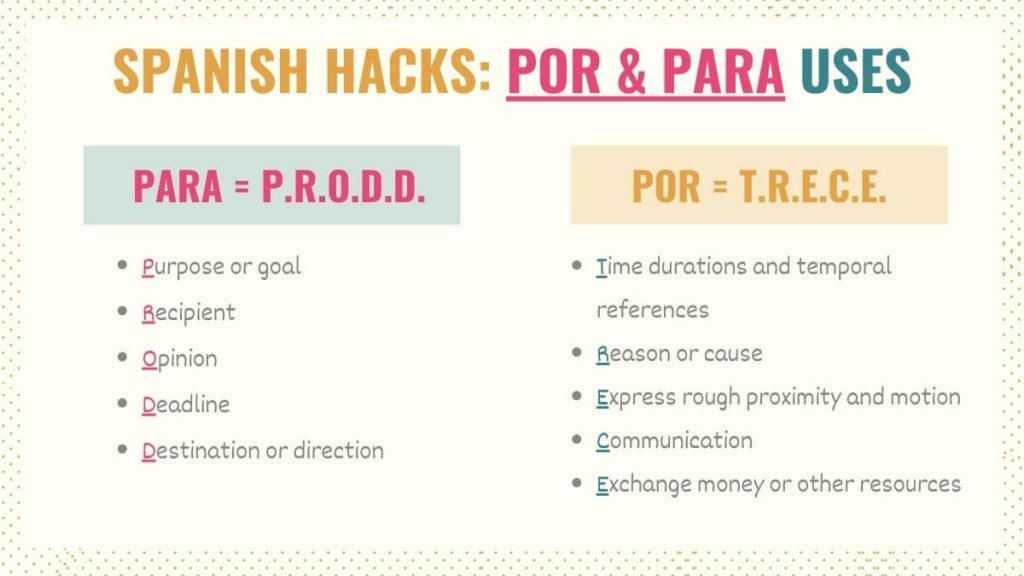
In the sections below, we’ll explore some situations where these prepositions are often confused.
Take Note: The preposition por is also used to form the passive voice in Spanish. This advanced application isn’t included in this por vs para guide because it’s usually never confused.
Difference Between Por and Para
At first glance, por and para seem to be applied in similar contexts. However, each one of these prepositions conveys different information. So, let’s check some situations where people struggle to see the difference between por and para.
As a shortcut, these prepositions respond to the following questions:
Por
- ¿Por que? – Why?
- ¿Por dónde? – What way?
- ¿Por cuánto tiempo? – For how long?
- ¿Por cuánto? – For how much?
- ¿A qué hora? – (At) What time?
- ¿Por quién – On behalf of whom/For whom?
Para:
- ¿Para qué? – What for?
- ¿Para dónde? – Where to?
- ¿Para cuándo? – For/By when?
- ¿Para quién? – To/for whom?
Por vs Para: Purpose vs Reason
In Spanish, the fundamental difference between para and por is that ‘para’ is used to express an action’s purpose or end goal, whereas ‘por’ refers to the reason why we do something.
Simply put, para conveys what we aim to accomplish with an action. For simplicity’s sake, I like to think about this ‘para’ application as the donkey and the carrot. To form this meaning, this preposition is often followed by infinitive verbs and, sometimes, nouns.
[Verb conjugated] + para + [infinitive / noun]
Louisa ahorra para su viaje.
Louisa is saving money for her trip.
Ellos se casaron para formar una familia.
They got married to form a family.
Te hablé para invitarte a nuestra boda.
I called you to invite you to our wedding.
On the other hand, por expresses the cause or reason to do something. In simple terms, it implies the reason behind someone’s actions. In this context, por is more commonly followed by Spanish nouns:
[Verb conjugated] + por + [nouns / infinitive]
Ellos se casaron por amor.
They got married for love.
Estoy preocupada por tu hermano.
I’m worried about your brother.
Nos pidió disculpas por habernos gritado.
He apologized for yelling at us.
Check the differences between se casaron para and se casaron por. The first implies the end goal of this marriage (having a family), while the second explains the root cause for them to marry (love).
Sometimes a reason or cause can be confused with a goal or purpose. Here’s another way to think about it:
- Por is triggered by past reasons and causes. The couple first fell in love, and then got married after.
- Para is triggered by future purposes and goals. The couple is getting married so they can start a family.
Take Note: As a tip, in this context, por responds to the question ‘why’, whereas para is the answer to ‘what for’. Based on this it’s common to say ‘gracias por…’ followed by why we’re thanking.
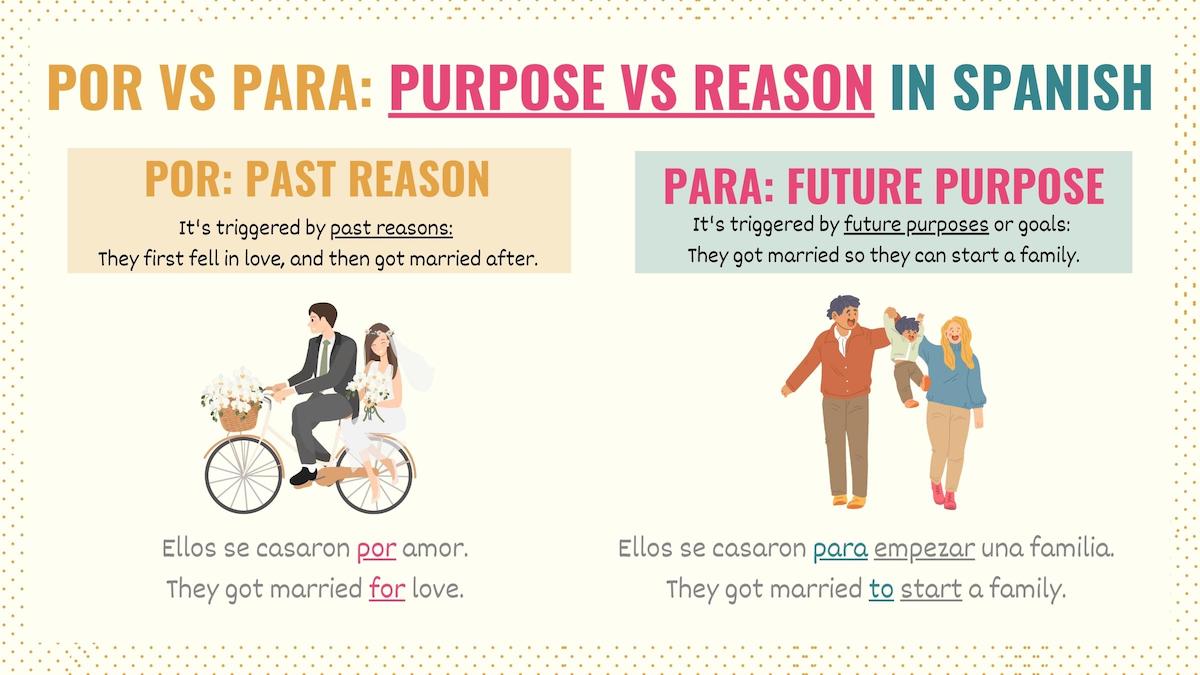
Para or por to talk about time
Although they both refer to time, these words convey specific and distinctive meanings. In Spanish, we use ‘para’ to talk about deadlines. With this meaning, ‘para’ can be followed by days of the week, months, or adverbs of time.
Para + [deadline]
El proyecto es para el jueves.
The project is for Thursday.
Tenemos que terminar para junio.
We must finish by June.
Este pago es para fin de mes.
This payment is for the end of the month.
When related to time, por refers to duration, frequency, and parts of the day:
Estamos libres por las tardes.
We’re free in the afternoon.
Tengo clases dos veces por semana.
I have classes twice per week.
Ella ha sido doctora por veinte años.
She has been a doctor for twenty years.
Take Note: In this context, para responds to the question ‘by when’ and por to ‘how long’, ‘how often’, or ‘when’.

Destination vs motion and approximate location
One of the main applications of ‘para’ is to express direction or destination (where someone or something is heading to). Check these sentences:
[Verb conjugated] + para + [complement]
Yo voy para la plaza.
I’m going to the mall.
No vayas para allá.
Don’t go there.
Tu hermano se fue para la oficina.
Your brother went to the office.
Por, on the other hand, is used to explain something or someone’s approximate location, routes, or express motion through space. For instance:
[Verb conjugated] + por + [complement]
Creo que no es por aquí.
I don’t think it’s this way.
La tienda está por la oficina.
The store is by the office.
Caminé por la plaza durante horas.
I walked around the mall for hours.
Take Note: Since they both convey direction, in many of these cases, ‘para’ is a close synonym of the preposition a.
Recipient vs cause
Here is a sentence with one of the most common mistakes people make when choosing between ‘por’ and ‘para’:
| Para sentence | Por sentence |
|---|---|
| Hice este cuadro para ti. I made this painting for you. | Hice este cuadro por ti. I made this painting for you. |
Both sentences are correct, but using one or the other depends on what you intend to say.
Para followed by a person or Spanish prepositional pronoun conveys that a person receives something (he or she is a recipient). Por can be followed by the same words, but it expresses that this person is the influence or inspiration to do something (cause).
So, even though both sentences are grammatically correct, you must remember that they don’t express the same thing.
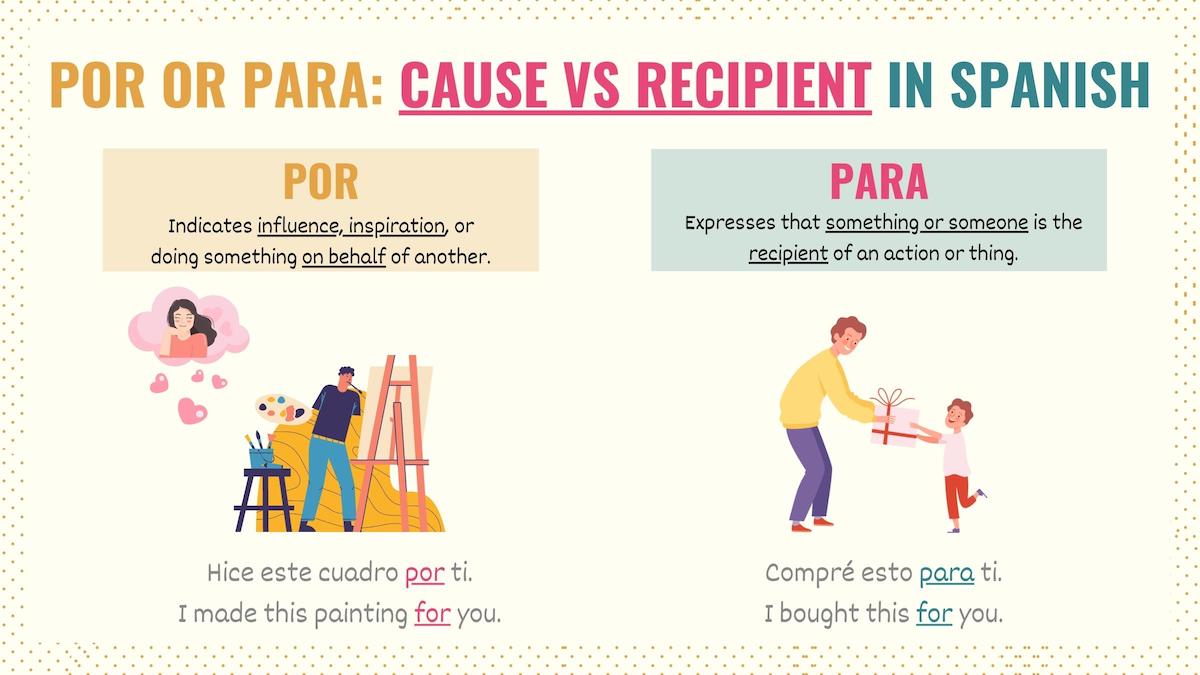
Bonus: Expressions with Por and Para
On top of helping you form your sentences, por and para are also used in many common idiomatic expressions. Here is a list of phrases that you can use to sound more natural.
Common expressions with por
- Estar por: To be about to
- Por algo: For a reason
- Por cierto: By the way
- Por las buenas: By fear means
- Por lo menos: At least
- Por poco: Nearly / Almost
- Por respeto: Out of respect
- Por si acaso: Just in case
- Por suerte: Luckily
- Por todas partes: Everywhere
- Por último: Finally
- Por una vez: For once
Expressions with para
- Bueno para nada: Good for nothing
- Dar para más: Have more to give
- De acá para allá: All over the place
- Durar para siempre: Last forever
- Para colmo: To make things worse
- Para llevar: To take
Key Points
Por vs para is one of the most challenging topics for Spanish learners. However, it’s also a crucial topic to express yourself correctly. Here are some key points you should never forget:
- Por and para are Spanish prepositions.
- Although they may be used in similar situations or share the same translation, these words express different meanings.
- In a nutshell, the difference between por and para is that ‘para’ expresses the purpose or end goal of something, whereas ‘por’ conveys the cause of why we do something.
- In Spanish, ‘para’ is used to talk about purposes, recipients, direction or destination, deadlines, and opinions.
- On the other hand, we use ‘por’ to refer to causes and reasons, communication means, exchange of money or resources, approximate location and motion, and time.
- When expressing purpose or reason, ‘para’ refers to the end goal of something, while ‘por’ conveys the reason behind something.
- Think about the donkey and carrot (para) vs a reason to do something (por).
- ‘Por’ answers the question ‘why’, while ‘para’ responds to ‘what for’.
- Even though they both refer to time, ‘para’ relates to deadlines and ‘por’ to duration, parts of the day, and frequency.
- When referring to people, ‘para’ expresses that such a person receives something, whereas ‘por’ conveys that this person is why we do something (inspiration, influence).
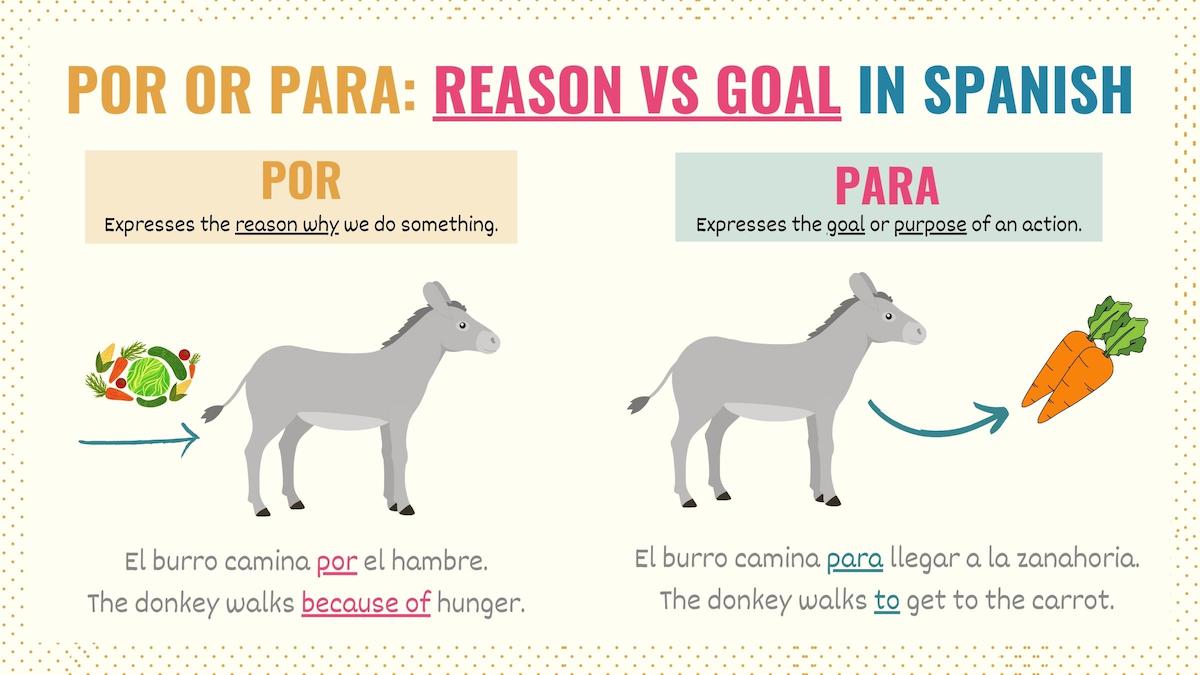
I encourage you to take our por vs para practice quiz to solidify this knowledge.
Por vs Para Additional Spanish Resources
Por and para allow you to express time, destination, purpose, cause, and destination, among other uses. Like these terms, other basic prepositions in Spanish can help you form sentences and improve your communication.
Prepositions, such as ‘para’ and ‘por’, cannot be followed by subject pronouns. Click on the following link to learn the pronouns you must use after prepositions. Finally, like ‘por’ and ‘para’, other tricky words in Spanish that can hurt your fluency.
Por vs Para Practice Quiz
After reading this guide, you now know all the key uses, rules, and situations in which to use por and para correctly. While the information is still fresh, take the por vs para practice quiz to exercise what you’ve learned and commit it to your long-term memory.
Download the Por and Para Download
Learning the difference between por and para in Spanish and using them correctly in your conversations will make you sound much more natural and fluent. But it can take some time to get it down perfectly. Download a copy of the free PDF for this guide with all the main notes, graphics and key points so you can review it whenever you need a refresher.

